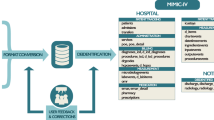Abstract
The rapid increase in adoption of electronic health records (EHRs) creates the possibility of tracking billions of patient visits per year and exploiting them for clinical research. The international observational research collaboration, Observational Health Data Sciences and Informatics (OHDSI), has counted 682 million patient records that have been converted to a common format known at the OMOP Common Data Model [1]. While this number includes duplicates and records that have not been made broadly available to researchers, its scale demonstrates that converting the world population to a common format is feasible.
Access this chapter
Tax calculation will be finalised at checkout
Purchases are for personal use only
Preview
Unable to display preview. Download preview PDF.
Similar content being viewed by others
References
Hripcsak, G., Duke, J.D., Shah, N.H., Reich, C.G., Huser, V., Schuemie, M.J., Suchard, M.A., Park, R.W., Wong, I.C.K., Rijnbeek, P.R., van der Lei, J., Pratt, N., Norén, G.N., Lim, Y.C., Stang, P.E., Madigan, D., Ryan, P.B.: Observational Health Data Sciences and Informatics (OHDSI): opportunities for observational researchers. In: MEDINFO 2015, São Paulo, Brazil, August 19-23 (2015)
Hripcsak, G., Albers, D.J.: Next-generation phenotyping of electronic health records. J. Am. Med. Inform. Assoc. 20, 117–121 (2013), doi:10.1136/amiajnl-2012-001145.
Hripcsak, G., Knirsch, C., Zhou, L., Wilcox, A., Melton, G.B.: Bias associated with mining electronic health records. J. Biomed. Discov. Collab. 6, 48–52 (2011), PMC3149555
Hripcsak, G., Albers, D.J.: Correlating electronic health record concepts with health care process events. J. Am. Med. Inform. Assoc. 20(e2), e311-e318 (2013), doi:10.1136/amiajnl-2013-001922.
Hripcsak, G., Ludemann, P., Pryor, T.A., Wigertz, O.B., Clayton, P.D.: Rationale for the Arden Syntax. Comput. Biomed. Res. 27, 291–324 (1994)
Zhou, L., Hripcsak, G.: Temporal reasoning with medical data - A review with emphasis on medical natural language processing. J. Biomed. Inform. 40, 183–202 (2007)
Uzuner, Ö., Stubbs, A., Sun, W.: Chronology of your health events: Approaches to extracting temporal relations from medical narratives. J. Biomed. Inform. 46, S1–S4 (2013)
Zhou, L., Parsons, S., Hripcsak, G.: The evaluation of a temporal reasoning system in processing clinical discharge summaries. J. Am. Med. Inform. Assoc. 15, 99–106 (2008), PMC2274869
Sun, W., Rumshisky, A., Uzuner, O.: Temporal reasoning over clinical text: the state of the art. J. Am. Med. Inform. Assoc. 20, 814–819 (2013)
Hripcsak, G., Elhadad, N., Chen, C., Zhou, L., Morrison, F.P.: Using empirical semantic correlation to interpret temporal assertions in clinical texts. J. Am. Med. Inform. Assoc. 16, 220–227 (2009), PMC2649319
Lasko, T.A., Denny, J.C., Levy, M.: Computational phenotype discovery using unsupervised feature learning over noisy, sparse, and irregular clinical data. PLoS One 8, e66341 (2013)
Liu, Z., Hauskrecht, M.: Sparse linear dynamical system with its application in multivariate clinical time series. In: NIPS 2013 Workshop on Machine Learning for Clinical Data Analysis and Healthcare (December 2013)
Wang, F., Lee, N., Hu, J., Sun, J., Ebadollahi, S.: Towards heterogeneous temporal clinical event pattern discovery: a convolutional approach. In: KDD 2012, Beijing, China, August 12-16, pp. 453–461 (2012)
Batal, I., Valizadegan, H., Cooper, G.F., Hauskrecht, M.: A pattern mining approach for classifying multivariate temporal data. In: Proceedings IEEE Int. Conf. Bioinformatics Biomed., pp. 358–365 (2011)
Noren, G.N., Hopstadius, J., Bate, A., Star, K., Edwards, I.R.: Temporal pattern discovery in longitudinal electronic patient records. Data Min. Knowl. Discov. 20, 361–387 (2010)
Shahar, Y.: A framework for knowledge-based temporal abstraction. Artificial Intelligence 90(1-2), 79–133 (1997)
Moskovitch, R., Shahar, Y.: Medical temporal-knowledge discovery via temporal abstraction. In: AMIA Annu. Symp. Proc., pp. 452–456 (2009)
Sebastiani, P., Mandl, K.D., Szolovits, P., Kohane, I.S., Ramoni, M.F.: A Bayesian dynamic model for influenza surveillance. Stat. Med. 25(11), 1803–1816 (2006)
Ramati, M., Shahar, Y.: Irregular-time Bayesian networks. In: Proceedings of the 26th Conference on Uncertainty in Artificial Intelligence (UAI 2010), Catalina Island, CA, USA (2010)
Albers, D.J., Hripcsak, G.: An information-theoretic approach to the phenome (abstract). In: AMIA Summit on Translational Bioinformatics, March 15-17, San Francisco, CA (2009)
Hripcsak, G., Albers, D.J., Perotte, A.: Parameterizing time in electronic health record studies. J. Am. Med. Inform. Assoc. (February 26, 2015), pii: ocu051, doi: 10.1093/jamia/ocu051.
Lasko, T.A.: Nonstationary Gaussian process regression for evaluating repeated clinical laboratory tests. In: Proceedings of the Twenty-Ninth AAAI Conference on Artificial Intelligence, Austin, TX, January 25-30 (2015)
Albers, D.J., Hripcsak, G.: A statistical dynamics approach to the study of human health data: resolving population scale diurnal variation in laboratory data. Physics Letters A 374, 1159–1164 (2010), PMC2882798
Albers, D.J., Hripcsak, G.: Using time-delayed mutual information to discover and interpret temporal correlation structure in complex populations. Chaos 22, 013111 (2012), doi:10.1063/1.3675621
Albers, D.J., Hripcsak, G.: Estimation of time-delayed mutual information and bias for irregularly and sparsely sampled time-series. Chaos, Solitons & Fractals 45, 853–860 (2012), PMC3332129
Komalapriya, C., Thiel, M., Ramano, M.C., Marwan, N., Schwarz, U., Kurths, J.: Reconstruction of a system’s dynamics from short trajectories. Phys. Rev. E 78, 066217 (2008)
Hripcsak, G., Albers, D.J., Perotte, A.: Exploiting time in electronic health record correlations. J. Am. Med. Inform. Assoc. 18(suppl. 1), i109–i115 (2011)
Claassen, J., Albers, D., Schmidt, J.M., De Marchis, G.M., Pugin, D., Falo, C.M., Mayer, S.A., Cremers, S., Agarwal, S., Elkind, M.S.V., Connolly, E.S., Dukic, V., Hripcsak, G., Badjatia, N.: Nonconvulsive seizures in subarachnoid hemorrhage link inflammation and outcome. Annals of Neurology (in press)
Author information
Authors and Affiliations
Corresponding author
Editor information
Editors and Affiliations
Rights and permissions
Copyright information
© 2015 Springer International Publishing Switzerland
About this paper
Cite this paper
Hripcsak, G. (2015). Physics of the Medical Record: Handling Time in Health Record Studies. In: Holmes, J., Bellazzi, R., Sacchi, L., Peek, N. (eds) Artificial Intelligence in Medicine. AIME 2015. Lecture Notes in Computer Science(), vol 9105. Springer, Cham. https://doi.org/10.1007/978-3-319-19551-3_1
Download citation
DOI: https://doi.org/10.1007/978-3-319-19551-3_1
Publisher Name: Springer, Cham
Print ISBN: 978-3-319-19550-6
Online ISBN: 978-3-319-19551-3
eBook Packages: Computer ScienceComputer Science (R0)




